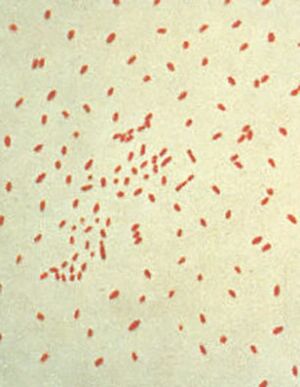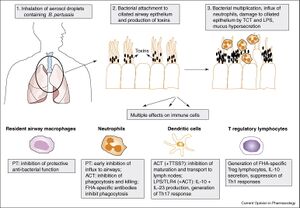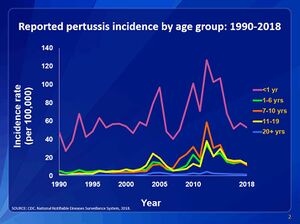Bordetella pertussis and the Importance of Vaccination: Difference between revisions
No edit summary |
|||
| Line 27: | Line 27: | ||
[[Image:1-s2.0-S1471489207000598-gr1.jpg|thumb|300px|right|This illustration depicts a three-dimensional (3D), computer-generated image, of a group of Gram-positive, Streptococcus agalactiae (group B Streptococcus) bacteria. The photo credit for this image belongs to Alissa Eckert, who is a medical illustrator at the [http://www.cdc.gov/ CDC].]] | [[Image:1-s2.0-S1471489207000598-gr1.jpg|thumb|300px|right|This illustration depicts a three-dimensional (3D), computer-generated image, of a group of Gram-positive, Streptococcus agalactiae (group B Streptococcus) bacteria. The photo credit for this image belongs to Alissa Eckert, who is a medical illustrator at the [http://www.cdc.gov/ CDC].]] | ||
<br> B. pertussis is a gram-negative, aerobic coccobacillus bacteria a part of the genus Bordetella<ref name=Guiso></ref>. Pertussis is a human-specific pathogen causing severe respiratory disease that cannot survive outside of its host<ref name=Guiso></ref>. Infection occurs with B. pertussis entering through the host airway via respiratory droplets from an already infected individual, usually from coughing <ref name=Smith> [https://academic.oup.com/femsre/article/25/3/309/624335/ Smith, A.M et al. "The virulence factors of <i>Bordetella pertussis<i>: a matter of control" 2001. FEMS Microbiology Reviews 25:309-333.]</ref>. B. pertussis then proceeds down the respiratory tract and adheres to ciliated epithelial cells in the trachea and nasopharynx <ref name=Smith></ref>. Once the bacteria is attached it begins to replicate and colonies with-in the host cells <ref name=Smith></ref>. Toxins are secreted by micro-organism which inflict damage to the epithelial lining, resulting in loss of ciliated cells which induces the coughing most commonly associated with whooping cough <ref name=Smith></ref>. The pertussis toxins released also allow the bacteria to avoid host immune response by interfering with clearance mechanisms <ref name=Smith></ref>. The damage caused by the toxins released by the replicating bacteria also halts ciliary function, short-circuiting host G proteins signaling apparatus, and also inhibits immune cell functions by up regulating cAMP levels <ref name=Smith></ref>. | <br> <i>B. pertussis<i> is a gram-negative, aerobic coccobacillus bacteria a part of the genus Bordetella<ref name=Guiso></ref>. <i>Pertussis<i> is a human-specific pathogen causing severe respiratory disease that cannot survive outside of its host<ref name=Guiso></ref>. Infection occurs with <i>B. pertussis<i> entering through the host airway via respiratory droplets from an already infected individual, usually from coughing <ref name=Smith> [https://academic.oup.com/femsre/article/25/3/309/624335/ Smith, A.M et al. "The virulence factors of <i>Bordetella pertussis<i>: a matter of control" 2001. FEMS Microbiology Reviews 25:309-333.]</ref>. B. pertussis then proceeds down the respiratory tract and adheres to ciliated epithelial cells in the trachea and nasopharynx <ref name=Smith></ref>. Once the bacteria is attached it begins to replicate and colonies with-in the host cells <ref name=Smith></ref>. Toxins are secreted by micro-organism which inflict damage to the epithelial lining, resulting in loss of ciliated cells which induces the coughing most commonly associated with whooping cough <ref name=Smith></ref>. The pertussis toxins released also allow the bacteria to avoid host immune response by interfering with clearance mechanisms <ref name=Smith></ref>. The damage caused by the toxins released by the replicating bacteria also halts ciliary function, short-circuiting host G proteins signaling apparatus, and also inhibits immune cell functions by up regulating cAMP levels <ref name=Smith></ref>. | ||
<br> The infection of B. pertussis has an incubation period of seven through ten days but a range of four through 21 days <ref name=Havers></ref>. Infection consist of three stages: catarrhal, paroxysmal, and convalescent<ref name=Havers></ref>. Catarrhal stage starts the onset of symptoms including runny nose, sneezing, and a minor cough <ref name=Havers></ref>. One to two weeks later the cough becomes more severe and the disease progresses into the paroxysmal stage (Havers et al. 2021). A fever is either not present or has minimal presence during infection at any stage (Havers et al. 2021). The paroxysmal stage is commonly when whooping cough is diagnosed due to numerous, rapid coughs due to thick mucus | <br> The infection of <i>B. pertussis<i> has an incubation period of seven through ten days but a range of four through 21 days <ref name=Havers></ref>. Infection consist of three stages: catarrhal, paroxysmal, and convalescent<ref name=Havers></ref>. Catarrhal stage starts the onset of symptoms including runny nose, sneezing, and a minor cough <ref name=Havers></ref>. One to two weeks later the cough becomes more severe and the disease progresses into the paroxysmal stage (Havers et al. 2021). A fever is either not present or has minimal presence during infection at any stage (Havers et al. 2021). The paroxysmal stage is commonly when whooping cough is diagnosed due to numerous, rapid coughs due to thick mucus building up <ref name=Havers></ref>. The end of the paroxysmal stage begins with a high-pitched whoop and difficulty breathing where the infected individual may become cyanotic (blue or purple discoloration due to lack of oxygen)<ref name=Havers></ref>. These symptoms usually occur as attacks rather than continuous symptoms <ref name=Havers></ref>. They occur more often during the night and may reach 15 attacks in 24 hours<ref name=Havers></ref>. This stage may last anywhere from one week to 10 weeks <ref name=Havers></ref>. The convalescent stage consists of a gradual recovery yet paroxysmal symptoms may reoccur and cause respiratory infections for months after diagnosis <ref name=Havers></ref>. | ||
==<i>B. Pertussis</i> Vaccine History== | ==<i>B. Pertussis</i> Vaccine History== | ||
Revision as of 14:16, 15 April 2022
Introduction and History

By Alexandra White
At right is a sample image insertion. It works for any image uploaded anywhere to MicrobeWiki.
The insertion code consists of:
Double brackets: [[
Filename: download.jpg
Thumbnail status: |thumb|
Pixel size: |300px|
Placement on page: |right|
Legend/credit:
Closed double brackets: ]]
Other examples:
Bold
Italic
Subscript: H2O
Superscript: Fe3+
Vaccination is a widely used practice to help prevent infectious disease and commonly spread illnesses. A widely known and common vaccine is used to prevent infection of Bordetella pertussis, the causative agent of Whooping cough. Whooping cough is known as one of the most common infectious disease deaths in the world[1]. The disease results in over 50 million cases worldwide per year, with the majority being unvaccinated individuals present in Third World Countries[1].
B. pertussis is spread through coughing and sneezing and symptoms first appear seven to ten days after infection[2]. These symptoms include: fever, runny nose, coughing which develops into a whooping cough, and phenomena[2]. Those infected with pertussis are contagious for around three weeks once coughing is displayed as a symptom yet symptoms can last up to eight weeks[2].
B. pertussis was first discovered and isolated to be the cause of whooping cough in 1906 [1].Compared to human infectious diseases pertussis is a relatively recent human infectious disease that first appeared in France in 1414[3].The disease was identified in Paris, France in 1900 by Jules Bordet and Octave Gengou who obtained the sample from a 5-month-old child[3]. The bacteria was finally isolated in 1906 from Jules Bordet’s own son[1]. A vaccine for B. pertussis was developed in the early 1940s [4]. Before the development of the vaccine there were over 200,000 cases in the United States reported annually and with widespread use incidence has decreased 75% compared to the pre-vaccination era[4].
Bordetella pertussis and Infection Stages
Italic

B. pertussis is a gram-negative, aerobic coccobacillus bacteria a part of the genus Bordetella[3]. Pertussis is a human-specific pathogen causing severe respiratory disease that cannot survive outside of its host[3]. Infection occurs with B. pertussis entering through the host airway via respiratory droplets from an already infected individual, usually from coughing [5]. B. pertussis then proceeds down the respiratory tract and adheres to ciliated epithelial cells in the trachea and nasopharynx [5]. Once the bacteria is attached it begins to replicate and colonies with-in the host cells [5]. Toxins are secreted by micro-organism which inflict damage to the epithelial lining, resulting in loss of ciliated cells which induces the coughing most commonly associated with whooping cough [5]. The pertussis toxins released also allow the bacteria to avoid host immune response by interfering with clearance mechanisms [5]. The damage caused by the toxins released by the replicating bacteria also halts ciliary function, short-circuiting host G proteins signaling apparatus, and also inhibits immune cell functions by up regulating cAMP levels [5].
The infection of B. pertussis has an incubation period of seven through ten days but a range of four through 21 days [4]. Infection consist of three stages: catarrhal, paroxysmal, and convalescent[4]. Catarrhal stage starts the onset of symptoms including runny nose, sneezing, and a minor cough [4]. One to two weeks later the cough becomes more severe and the disease progresses into the paroxysmal stage (Havers et al. 2021). A fever is either not present or has minimal presence during infection at any stage (Havers et al. 2021). The paroxysmal stage is commonly when whooping cough is diagnosed due to numerous, rapid coughs due to thick mucus building up [4]. The end of the paroxysmal stage begins with a high-pitched whoop and difficulty breathing where the infected individual may become cyanotic (blue or purple discoloration due to lack of oxygen)[4]. These symptoms usually occur as attacks rather than continuous symptoms [4]. They occur more often during the night and may reach 15 attacks in 24 hours[4]. This stage may last anywhere from one week to 10 weeks [4]. The convalescent stage consists of a gradual recovery yet paroxysmal symptoms may reoccur and cause respiratory infections for months after diagnosis [4].
B. Pertussis Vaccine History
Include some current research, with at least one figure showing data.
Italic
Soon after B. pertussis was isolated as the causative agent of whooping cough, Pertussis whole-cell (Pw) vaccines were implemented using heat-killed bacteria [3]. Pw vaccines became used for wholesale distribution starting in the 1940’s [6]. Since B. pertussis in human host resrictive, there is a very low display of genetic diversity [3]. Recent analyses have concluded that there were several different types of isolates circulating in the prevaccine era that produce various proteins [3]. Only one or two types predominated with no significant difference in an associated pattern to which was the dominant isolate [3]. This allowed for the Pw vacine to be composed of 1-3 strains selected from the predominant isolate types [3]. Pw vaccines were given to infants and toddlers extensively due to the majority of infections occuring in younger children [3]. Where vaccine distribution was effective, vaccine strains of B. pertussis were low and in areas with low vaccination rates the pre-vaccine era isolated were still circulating [3]. Pw vaccines were shown to create immunity for some isolates of B. pertussis but not all isolates [3].
Vaccine Virulence
Include some current research, with at least one figure showing data.
Why Vaccination?

Conclusion
References
- ↑ 1.0 1.1 1.2 1.3 Kerr, J.R. and Matthews, R.C."Bordetella pertussis Infection: Pathogenesis, Diagnosis, Management, and the Role of Protective Immunity." 2000. European Journal of Clinical Microbiology and Infectious Disease 19:77-88.
- ↑ 2.0 2.1 2.2 World Health Organization: Pertussis 2018
- ↑ 3.00 3.01 3.02 3.03 3.04 3.05 3.06 3.07 3.08 3.09 3.10 3.11 Guiso, N. "Bordetella pertussis and Pertussis Vaccines." 2009. Clinical infectious Diseases 49:1565-1569.
- ↑ 4.00 4.01 4.02 4.03 4.04 4.05 4.06 4.07 4.08 4.09 4.10 Havers et al. "Pertussis." 2021. Center for Disease Control and Prevention. 1-16.
- ↑ 5.0 5.1 5.2 5.3 5.4 5.5 Smith, A.M et al. "The virulence factors of Bordetella pertussis: a matter of control" 2001. FEMS Microbiology Reviews 25:309-333.
- ↑ Mattoo, S. Cherry, J.D. "Molecular Pathogenesis, Epidemiology, and Clinical Manifestations of Respiratory Infections Due to Bordetella pertussis and Other Bordetella Subspecies" 2005. Clinical Microbiology Reviews
Authored for BIOL 238 Microbiology, taught by Joan Slonczewski, 2022, Kenyon College
